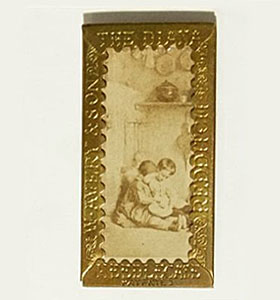Diana

Needle Case (sepia print: Woman holding small girl, sewing or making lace - version 1)

Patent
Design Details
Needle Case Type: |
Flat-Names |
Patent/Registered to: |
William Avery - Redditch Manufacturer |
Patent/Design Representation #: |
Mechanical Patent #: 1322 (Fig. 7 & 8) |
Patent/Design Registration Date: |
May 16, 1871 |
Location of Patent/Design Registration: |
British Library - Business and Intellectual Property Centre - London
|
Reference #: |
1871-1322 |
Dimensions: |
3.0 x 4.6
2.4 x 4.7
2.3 x 4.3 |
Material: |
Brass |
Name Variations: |
W. Avery & Son - Redditch |
Different Sepia Prints: |
a) Man consoling woman
b) Seated woman holding young boy
c) Victorian boy sitting on seat yawning with eyes closed
d) Washer Woman
e) Woman with child collecting firewood
f) Woman holding small girl, sewing or making lace - version 1
g) Woman holding small girl, sewing or making lace - version 2
h) Woman sitting with angel/cherub watching over her in clouds
i) Woman with head back downing a drink
j) Woman with little girl holding a basket
k) Young girl praying
l) Young girl with kittens
m) Young child in a field
n) Two children playing |
Additional Photographs


Back and back detail


Different sepia prints: Seated woman holding a young boy (photo from eBay) and Woman with child collecting firewood (photo courtesy of Jean Scott)


Different sepia prints: Young girl praying (photo courtesy of Bunny's Place) and Young girl with kittens (photo
courtesy of Loene McIntyre)


Different sepia prints: Woman with head back downing a drink (photo courtesy of Lynda Herrod) and Man consoling woman (photo courtesy of Christina Bertrand)


Different sepia prints: Victorian boy sitting on seat yawning with eyes closed and Woman sitting with angel/cherub
watching over her in clouds (photos from eBay 2006)


Different sepia prints: Woman holding small girl, sewing or making lace - version 2 and Young child in a field (photo courtesy of Lynda Herrod)


Different sepia print: Washer Woman and Two children playing (photo from eBay)

Different sepia print: Woman with little girl holding a basket (photo courtesy of Shelby Coleman)
Facts
Diana is the Roman mythological goddess of the hunt and the moon and is equated to the Greek goddess Artemis. She is typically depicted as
a beautiful, young woman in a short tunic and hunting boots with a bow, quiver and animals as the huntress or in a chariot drawn by white stags or
horses as the moon goddess. A crescent moon is often worn on her forehead. She was also worshipped as the virgin goddess of women and
childbirth.

History
Diana, daughter of Jupiter and Latona, was the twin of Apollo the sun god. She along with Minerva and Vesta was one of three goddesses
vowing to never marry. She was depicted as a free spirited and strong female. As the huntress she preferred to live in the woodlands and
mountains where she was able to communicate with animals. The oak grove was sacred to her. Interestingly, she was thought to be capable
of great vengeance and cruelty to anyone who threatened her or her chastity. One theory for her common depiction with a stag relates not to
her association with hunting but to the story of the fate of Acteon who saw her bathing naked so was transformed by her into a stag which she then
set his own hunting hounds upon to kill. Diana was worshipped in cults and religions. Women made offerings to her wanting pregnancy and easy
child birth. In Victorian times her image was a popular subject on cameos. This might be because as a strong woman she was a symbol of
the emerging strength of females in Victorian society or perhaps since childbirth at that time remained quite risky, there was still some association
with seeking Diana’s protection.

Miscellaneous
The Diana needle case featured sepia prints. Sepia, a brownish pigment from the ink sac of common cuttlefish, was first uses in photography
around 1880 to stabilise the positive print and increase its longevity. Sepia had been used as ink from ancient times. Photography began
in a practical sense in 1839. By 1842 Queen Victoria and Albert were collecting photographs and had many family portraits which were taken for
private rather than public intent. It is said that many visitors to the Crystal Palace Exhibition in 1851 saw their first photograph. In
1854, a technique for producing multiple small photographs on one negative was patented in France by photographer André-Adolphe-Eugène Disdéri.
These photos called carte de visite became very popular after he produced a portrait of Napoleon III. They were an albumen print, a technique
which enabled the first multiple prints to be made from a negative, and were a thin paper photo mounted on paper card. The resulting images
were the size of a visiting card and soon the collecting and displaying of these photographs became a craze with albums used in Victorian parlours
to display collections. In 1860 Queen Victoria allowed portrait photos of the royal family to be issued in the carte de visite format.

Note: Right side panel text and photos provided by Lynda Herrod.
























